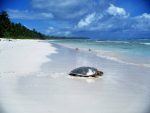Profile
During that 1996 Expedition and again as part of the 2006 Chagos Expedition I conducted the first systematic scientific surveys of turtle nesting activity ever conducted in this region, enabling an assessment of spatial distribution of nesting activity throughout the five islanded atolls of the Chagos Archipelago. In 1999 I visited to focus on the turtle populations of the expansive Diego Garcia atoll, and I identified a 2.8 km long Index Beach on Diego Garcia and set up a long-term turtle beach monitoring program. This ongoing program, implemented semi-monthly by base personnel of the Department of Environment and by local volunteers, has enabled us to define nesting seasonality and quantify annual egg clutch production throughout this region.
Another study, ongoing since 1996 is the long-term mark-recapture study of immature hawksbills at Turtle Cove on Diego Garcia, which has documented their growth rates, foraging sites, and genetic connectivity between nesting and foraging turtles of the Indian Ocean Region and those of the wider region. In 2012, I joined forces with Prof. Graeme Hays and Dr. Nicole Esteban. We sourced funding from the Bertarelli Foundation enabling us to expand their programme of satellite tracking post-nesting female green turtles and to also track post-nesting hawksbills, as well as immature turtles foraging in Turtle Cove.
We estimate an average of 6,300 hawksbill and 20,500 green turtle egg clutches were laid annually in the Chagos Archipelago during 2011-2018. This represents an estimated 40-50% of all hawksbill and 15-20% of all green turtle egg clutches laid throughout the entire southwestern Indian Ocean region.
Biography
My Project
Other interests
Since 1995, based in the Republic of Seychelles, I have engaged in research and conservation of marine turtles and coastal and marine habitats, especially beach habitats and seagrass ecosystems. I am Technical Advisor to and member of the governing Council of Island Conservation Society (ICS), the largest eNGO in Seychelles with a mandate to implement conservation activities on most of the Government-owned inner and outer islands of Seychelles.
My Publications

A Global Assessment of Microplastic Abundance and Characteristics on Marine Turtle Nesting Beaches
Botterell, Z.L.R., et al (includes Esteban, N., Hays, G.C., Mortimer, J.A.) (2025). A global assessment of microplastic abundance and characteristics on marine turtle nesting beaches. Marine Pollution Bulletin.

Low Growth Rates at High Population Densities in Sea Turtles
Mortimer, J.A., Esteban, N., Laloe, J.-O., Stokes, H.J., Tromp, J.J., Hays, G.C. (2025) Low growth rates at high population densities in sea turtles. Marine Biology.

Assessing the Impacts of Satellite Tagging on Growth of Immature Hawksbill Turtles
Stokes, H.J., Stokes, K.L., Mortimer, J.A., Laloe, J-O., Esteban, N., Hays, G.C. (2024). Assessing the impacts of satellite tagging on growth of immature hawksbill turtles. Methods in Ecology and Evolution.

Remote Submerged Banks and Mesophotic Ecosystems Can Provide Key Habitat for Endangered Marine Megafauna
Hays, G.C., Laloë, J-O., Mortimer, J.A., Rattray, A., Tromp, J.J., Esteban, N. (2024). Remote submerged banks and mesophotic ecosystems can provide key habitat for endangered marine megafauna. Science Advances.

Synergistic Use of UAV Surveys, Satellite Tracking Data and Mark-Recapture to Estimate Abundance of Elusive Species
Stokes, H.J., Mortimer, J.A., Laloë, J.-O., Hays, G.C., Esteban, N. (2023). Synergistic use of UAV surveys, satellite tracking data and mark-recapture to estimate abundance of elusive species. Ecosphere.





